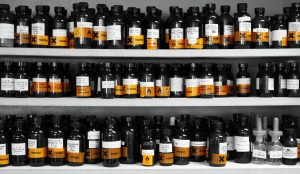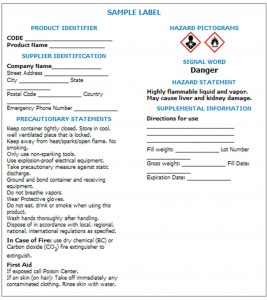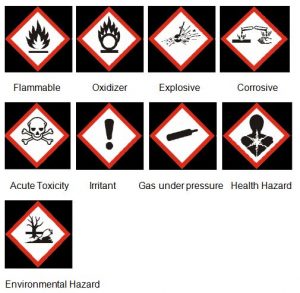
Print a Sign-In Sheet | Spanish Version Coming Soon
The Occupational Safety and Health Administration (OSHA) has updated the requirements for labeling of hazardous chemicals under the Hazard Communication Standard. As of June 1, 2015, all labels will be required to have the product identifier, supplier identification, precautionary statements, a signal word, hazard statements, and hazard pictograms.
 Product identifier – Hazardous chemical identifier including, but not limited to, the chemical name, code number, or batch number. The manufacturer, importer, or distributor can decide the appropriate product identifier. The same product identifier must be both on the label and in section 1 of the Safety Data Sheet (SDS).
Product identifier – Hazardous chemical identifier including, but not limited to, the chemical name, code number, or batch number. The manufacturer, importer, or distributor can decide the appropriate product identifier. The same product identifier must be both on the label and in section 1 of the Safety Data Sheet (SDS).
Supplier identification – Name, address, and telephone number of the chemical manufacturer, importer, or other responsible party.
Precautionary statements – Recommended measures that should be taken to minimize or prevent exposure to the hazardous chemical or improper storage and handling of the chemical. For example, “Wear Face Protection.”
Signal word – Relative level of severity of the hazard. There are only two signal words, “Danger” and “Warning.” “Danger” is used for more severe hazards and “Warning” is used for less severe hazards. There will only be one signal word on the label no matter how many hazards a chemical may have or how severe a chemical may be.
Hazard statements – Nature of the chemical hazard(s). For example, “Causes damage to kidneys through prolonged or repeated exposure when absorbed through the skin.” All applicable hazard statements must appear on the label.
Hazard pictograms – Graphic symbols used to communicate specific information about the hazards of a chemical. The new labeling requirements use nine pictograms but OSHA will only enforce eight: health hazard, flame, exclamation mark, gas cylinder, corrosion, exploding bomb, flame over circle, skull and crossbones, and environment (nonmandatory under OSHA).
It is important for employees to understand the labeling requirements and pictograms for each hazard.

does not assume liability for the content of information contained herein. Safety and health remain your responsibility. This information is to be used for informational purposes only and not intended to be exhaustive or a substitute for proper training, supervision, or manufacturers’ instructions/recommendations. KEMI, by publication of this information, does not assume liability for damage or injury arising from reliance upon it. Compliance with this information is not a guarantee or warranty that you will be in conformity with any laws or regulations nor does it ensure the absolute safety of any person, place, or object, including, but not limited to, you, your occupation, employees, customers, or place of business.

